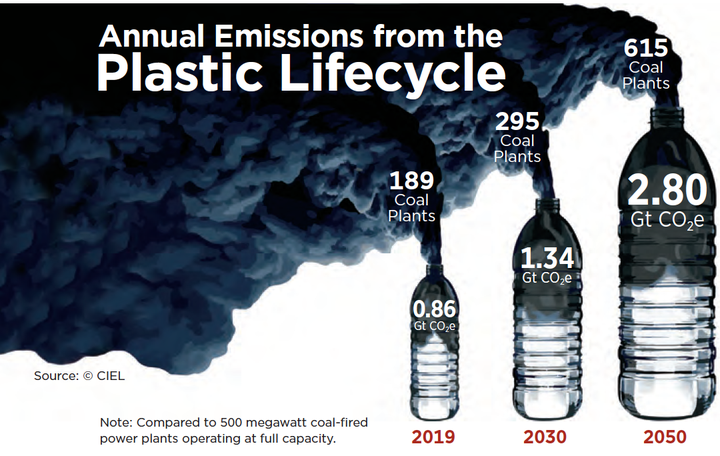By now, the headlines about dead whales washing ashore with pounds of plastic in their belly are commonplace. Photos of bird carcasses bursting with bottle caps and other plastic detritus are seared into our memory. But plastic’s effects on nature doesn’t stop there ― it’s also making climate change worse.
A new report published this week by the Center for International Environmental Law details the greenhouse gas emissions from each step in the lifecycle of plastics: from fossil fuel extraction, transport and refining to the production of consumer goods, the managing of plastic waste, and the proliferation of trash in the oceans. The study authors warn that, if demand for plastics continues to rise, the material’s contribution to climate change will grow significantly.
This year, emissions from plastics will equal the pollution output of nearly 200 coal-fired power plants with a 500-megawatt capacity, the report finds. The authors estimate that emissions from plastic will reach the equivalent of nearly 300 coal plants in 2030 and over 600 in 2050. They speculate that their predictions underestimate the situation, “due to limitations in the availability and accuracy of certain data.”
The report also warns that expanding current plastic production will make it “impossible” for the world to meet the Paris Climate Accord’s goal of preventing global warming from exceeding 2.7 degrees Fahrenheit above pre-industrial averages. United Nations scientists predict that warming beyond that point would result in catastrophic climate change.

“We need to cut emissions by 45 percent by 2030,” Carroll Muffett, president of CIEL, told Popular Science. “Plastics are poised to do almost exactly the opposite.”
“Once the plastics are released into the environment,” Muffett added, “they continue to impact the climate in perpetuity. Unless they are recycled, which the vast majority are not.”
Over 90% of plastics are not recycled, according to a major study published last year. Most of this waste is landfilled, while 12% is incinerated. In addition, millions of tons of plastic trash end up in the ocean each year.
Despite a growing awareness of the problem, demand for plastics has not waned. People bought over 300 million tons of new plastic in 2014, a figure that’s expected to more than double by 2030, according to research agency IHS Markit. The fracking boom in the United States is a primary driver of this growth. “Nowadays, the cheapest, most available way to make plastic is with natural gas,” IHS Markit trade numerologist John Miller told the trade publication Journal of Commerce earlier this year.
The CIEL report proposes solutions to our plastic crisis, recommending an end to the creation of single-use plastics, such as shopping bags and excessive wrapping for food items. The study authors also recommend putting a stop to the development of new oil, gas, and petrochemical infrastructure, and they state that plastic producers should be held responsible for their role in the problem.
This story is part of a series on plastic waste, funded by SC Johnson. All content is editorially independent, with no influence or input from the company.